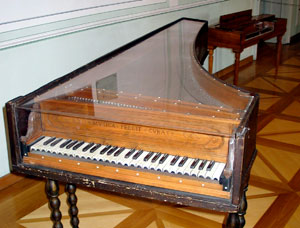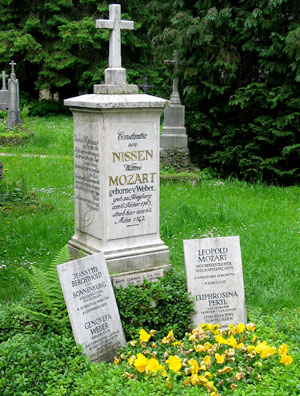SALZBURG, AUSTRIA – You don't have to look hard to find traces of Mozart in this city that gets its name from the salt mountains that surround it. The musical genius' image can be found in Salzburg's parks, city squares, public buildings and on thousands of chocolate boxes.
In fact, there are two buildings, one bridge, one square and one impressive statue dedicated to Mozart and the 25 years he spent here creating his early classics.
In 2006, Salzburg, the UNESCO World Heritage city that was first settled around 2000 BC, celebrated the 250th anniversary of Mozart's birth with great fanfare.
Millions of people poured into Salzburg and Vienna (he spent 10 years in the beautiful Austrian capital and died there prematurely at age 35) and joined in the lavish festivities the two cities - the country's cultural bookends – offered that year. Salzburg is a city divided into new and old sections by the murky River Salzach. Salzburg's new part, by the way, dates back to the Roman Empire.
Elaborate baroque fountains dominate the city's main squares and medieval buildings and giant church spires make up the skyline. A castle dating back to 1077 sits perched on a granite cliff overlooking the grand city, which is home to over 4,000 festivals each year. The biggest is the annual Salzburg Festival (usually held between July and August), which celebrates the classical works of composers like Mozart, the child protégé who took centre stage here in 1761 when at age 5 he made his first public appearance and continued to wow European audiences until his death in 1791.


Left: Mozart's first piano. Right: Mozart family grave does not contain remains of the great composer.
So, with my trusty Salzburg card in hand (it allows unlimited access to the city's excellent bus service and entrance to museums, including those dedicated to Mozart) I ventured out to enjoy all things pertaining to Mozart that the city offers.
First stop, his birthplace - a handsome yellow building at No. 9 Getreidegasse, a narrow street in the city's old quarter where the Mozarts rented space. I quickly discovered I was not the only Mozart fan - Salzburg expects between six and seven million tourists annually. I pushed my way through a large line-up and climbed the marble staircase of the nearly 1,000-year-old building to the fourth floor, past the family kitchen and into the room where Mozart's mother (Anna Maria) gave birth to her genius son on Jan. 27, 1756.
The museum home is crammed with Mozart memorabilia - family portraits, original sheet music in the master's own hand and ancient musical instruments.
That's also where I met a local guide named Christoph Seilern, a Mozart know-it-all who agreed to help lead me through Wolfgang Amadeus' hometown.
"This (No. 9) is very impressive but if you want to see an even better collection of Mozart, I will take you to No. 8 Makart Platz," the charming Seilern told me. "That's the (larger) home Mozart's father (Leopold) moved the family into after they started touring and making lots of money. It contains the original instruments Mozart used to create most of his classics. Come, I will show you."
I followed the guide through the narrow streets of the old city, the ones featuring charming shops, ornate fountains, quaint traditional Austrian restaurants, cozy hotels, churches and a marvelous cathedral. We passed Mozart Square, where a statue of the original Great One stands looking into the old streets.
It was not hard to see how this city inspired Mozart to create his great works - he composed over 2,000 in all in Salzburg and Vienna, according to music historians. While walking, I discovered Salzburg is a remarkable place - with or without Mozart.
The former walled city's impressive fortress, with its snow-capped mountain backdrop (Salzburg is where the Alps begin), catches your eye no matter where you are in this compact city of 150,000. Catacombs were chiseled out of the mountain on which the fortress sits like a crown, and can still be visited today. I noticed water gushing out of the mountain's base. According to my guide, Capuchin monks - cappuccino coffee was named after the colour of their robes - once lived in the area and dug through the granite to bring drinking water from another town. A marvelous engineering feat, considering the times.
We crossed the calm Salzach - its waters are not suitable for drinking - and into the city's "new" section, where a large building came into view.
"That is Mirabell Palace," said Seilern, pointing to the impressive structure with a huge formal garden in front of it. Mirabell was built by an archbishop for his mistress, who in turn rewarded him with 16 children. The word celibacy obviously had not been introduced back then.
"There will be a concert of Mozart's music at Mirabell tonight," said Seilern as we walked. "You should attend."
"Don't worry, I will," I enthusiastically told the guide as we reached the entrance of a pink-coloured building at No. 8 Makart Platz. As Seilern promised, inside the stately, refurbished home was a collection of Mozart's original instruments, including his precious fortepiano on which most of his classics were created, and another, smaller instrument that Seilern described as a "silent piano."
"Mozart used that instrument at night so he would not disturb his (two) sons," said the guide.
No. 8 Makart Platz was in total decay just a few years ago and in danger of being lost to the wreckers' ball because the city did not have the funds to repair it. However, a group of Mozart-loving Japanese came to the rescue and spearheaded a drive that led to the home being lovingly restored.
One of the displays tells how Mozart was taught to perfect his craft by Johann Michael Haydn, the brother of the far more famous Josef Haydn.
Again, more family portraits of the Mozarts (including one of his wife Constanze) were on display and an informative film at the end of the tour traced the fascinating life and troubled times of the flamboyant young musical genius, who, along with his sister Maria Anna, were paraded through the royal courts and concert halls of Europe by their father. All that attention apparently turned Mozart into a vulgar little man later in life, according to the frank exhibition.
As we walked through the home, Seilern dispelled some of the urban legends that have become part and parcel of the Mozart lore - like the fact he died poor and was buried in an unmarked pauper's grave.
"When he died he was in a lot of debt but was still living a lavish lifestyle," the guide assured me. "He was buried in a mass grave but that was because the ruler of the day decided that all pomp and ceremony surrounding funerals was a waste of time and ordered all commoners to be buried together.
"Remember, musicians, even great musicians like Mozart, were considered not much more than servants back then," said Serlein. "They have excavated mass graves in Vienna trying to locate Mozart's remains but the closest they have come is finding a hat they believe once belonged to him.
"They should be looking for the skull of a genius," laughed the guide.
Mozart may not be buried here but his father and wife are - in a family plot in a beautiful graveyard dominated by an impressive mausoleum dedicated to a former archbishop and featuring many ornate headstones and statues. His mother, who died while accompanying Wolfgang Amadeus on one of his tours, is buried in Paris.
After a few hours of studying every little detail about Mozart at No. 8 Makart Platz - including buying the obligatory mini bust of the great composer and a box of (delicious) Mozartkugen chocolates that bear his likeness - I strolled back into the Salzburg sunshine.
The recital of Mozart's works at Mirabell was still several hours away so we decided to wander the narrow streets of the charming old city. We came upon the city's cathedral and its overstated exterior. However, inside, the acoustically perfect venue, where the world's best musicians and opera singers beat a path each year to perform Mozart's works, is surprisingly understated.
There was also time to take a funicular to the fortress, which was never conquered. Once there, we visited a small dungeon-like section that featured a wonderful collection of antique marionettes - a style of entertainment still very popular with Austrians today that so impressed me, I later collected tickets (costing 35 euros each) for an excellent performance of Hansel and Gretel at the lovely Salzburg Marionette Theatre. A decision I had no "re-gretels" about, by the way.
On my way to the recital, I walked through Mirabell's marvellous gardens. Several spots in the palace gardens were used in the filming of The Sound of Music. A few metres away from a walkway where the von Trapp kids were caught playing on film is a little garden house where Mozart reportedly wrote his classic work The Magic Flute. Four large ornate statues dominate Mirabell's gardens. They depict the four elements - earth, wind, fire and water. The elevated rear of the gardens also gives you a fantastic view of the city.
Finally, the time had come for the Mozart recital. I broke out in goose bumps as I entered the baroque-style palace and climbed the statue-filled staircase leading to the building's wonderfully ornate Marble Hall, the very place where Mozart gave many performances for the aristocratic crowd of the day.
I lined up with a bunch of Frasier Cranes until an attendant swung open the hall's huge doors and revealed a gilded room that was simply stunning.
A lone white piano stood at the front of the hall and a hush fell over the audience as an Austrian pianist with the Anglo name - Esther Walker - took her place. Her renditions of Mozart's works were simply wonderful - each one prompting enthusiastic applause from the appreciative audience.
Suddenly, a bird, which had been caged in the palace walls for several weeks, flew across the gilded room and landed on a corner ledge.
A travelling companion leaned over and whispered: "Is that really a bird or is it Mozart?"
"It can't be Mozart," I said while sizing up the pigeon. "It's not a songbird."